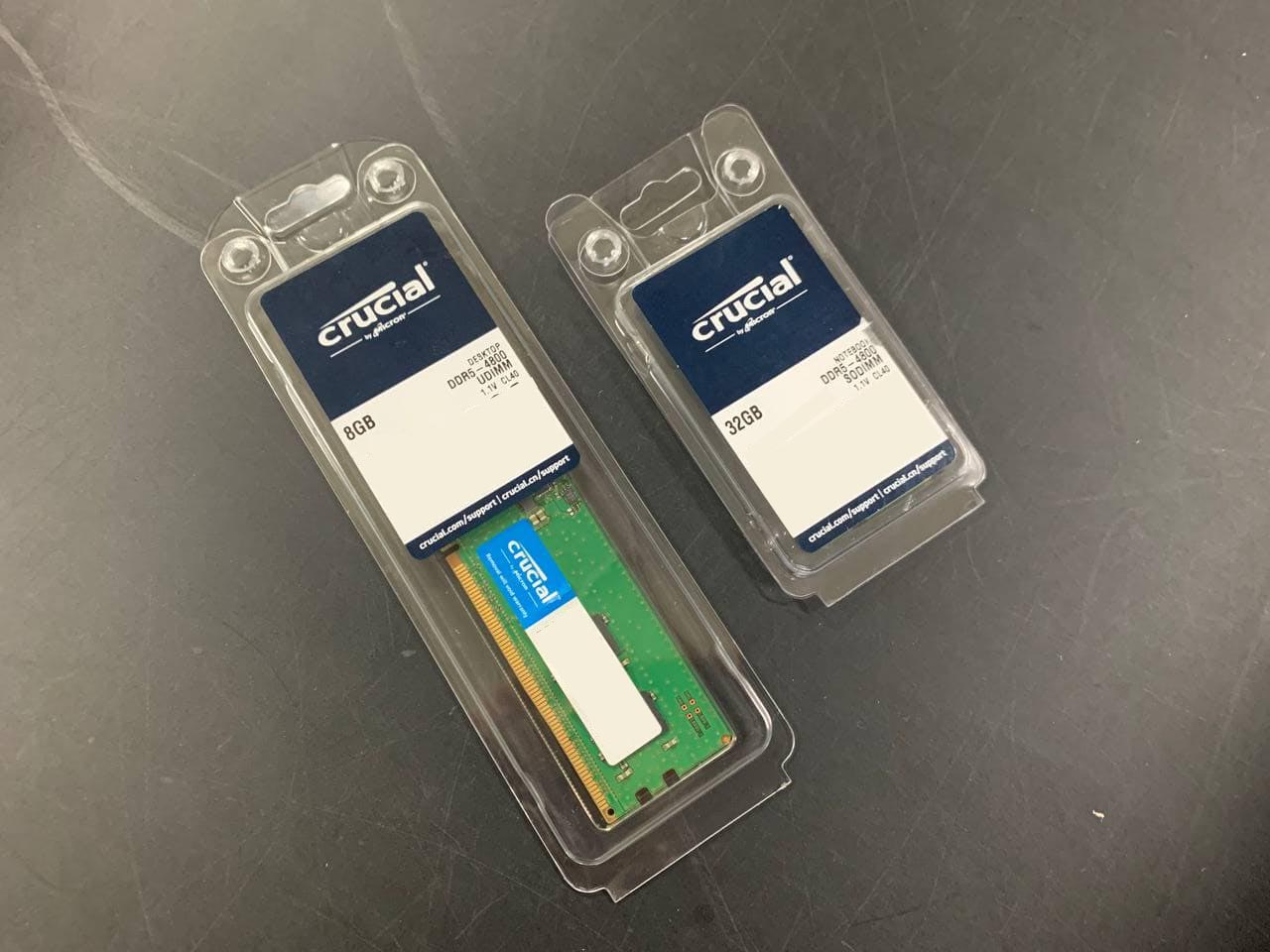It looks like DDR5 RAM is almost ready for purchase. Chinese news outlet XFastest this week shared photographs of the first retail DDR5 memory modules from Crucial, showing the components in retail packaging, just aching to hit shelves.
As seen in the images, the publication blocked out the information on the modules' sticker, reportedly so Crucial can't trace the modules.
Crucial's memory modules check in at DDR5-4800, but that's just the start. DDR5 is projected to hit 6,400 MHz, with some vendors already aiming for 10,000 MHz. Preliminary RAM benchmarks show DDR5 with massive uplifts in synthetic workloads, so it'll be interesting to evaluate DDR5's real-world benefits and how it stacks up to the best RAM kits on the market today.
The DDR5 sticks in question sport a CAS Latency (CL) value of 40 and a DRAM voltage requirement of 1.1V. The UDIMM has a capacity of 8GB, while the SO-DIMM sports a whopping 32GB.
As you can see in the pictures, Crucial DDR5 memory modules comes with a boring, green PCB. So we expect these to be budget offerings for value-conscious shoppers and OEMs. Don't worry though: High-end memory modules will likely arrive with fancy heat spreaders and tacky RGB illumination.
Crucial's memory modules utilize integrated circuits (ICs) from Micron. The UDIMM module features a one-side design with four 2GB memory ICs, while the SO-DIMM module sticks to a dual-sided design with up to 16 memory ICs of the same size. According to JEDEC's specification, DDR5 is expected to push the envelop in terms of capacity. The expected ceiling is 128GB per module.
Currently, we know about two processor families that will potentially support DDR5. On the Blue Team, we have Intel's upcoming 12th Generation Alder Lake hybrid desktop processors that are scheduled to hit the market in the second half of this year. For the Red Team, Zen 4 has been rumored to support DDR5 memory, which would make sense, since Zen 3 will be the last microarchitecture to go through the AM4 CPU socket. It wouldn't be surprising to see AMD use the new AM5 socket to exploit DDR5.
Get Tom's Hardware's best news and in-depth reviews, straight to your inbox.
AMD's Zen 4 isn't expected until next year, so Intel might beat AMD to DDR5 adoption as revenge for the latter embracing PCIe 4.0 first on a mainstream platform.

Zhiye Liu is a news editor, memory reviewer, and SSD tester at Tom’s Hardware. Although he loves everything that’s hardware, he has a soft spot for CPUs, GPUs, and RAM.
-
tennis2 Ehhh, why is DDR5-4800 CAS 40 when DDR4-4800 is CAS 19?Reply
That's going to negate all (or more) of the various other architectural performance improvements of DDR5. -
Kamen Rider Blade WTF, why is there a double height PCB for only 8 DRAM packages?Reply
Why are you wasting so much PCB when you could've easily packaged it on smaller PCB? -
hotaru.hino Reply
While I don't have an exact answer, we can speculate:tennis2 said:Ehhh, why is DDR5-4800 CAS 40 when DDR4-4800 is CAS 19?
That's going to negate all (or more) of the various other architectural performance improvements of DDR5.
DDR4-4800 isn't part of the JEDEC spec.
At least on Ryzen systems, memory controllers can't clock that fast anyway, so there's additional latency due to addressing memory at less than 1:1 clock speeds. If AMD's slide deck was any indication, DDR4-4400 CL18's latency isn't any better than DDR4-3200 CL14 when put into practice.
The absolute latency isn't that much better or worse than the JEDEC standard for DDR4 in its entirety
Assuming the table on Wikipedia is listing the official JEDEC standards for DDR4, it's likely JEDEC is being generous with timings and we'll likely see memory with faster timings becoming more mainstream
Probably logistics. It's easier to mass produce one item than two.Kamen Rider Blade said:WTF, why is there a double height PCB for only 8 DRAM packages?
Why are you wasting so much PCB when you could've easily packaged it on smaller PCB? -
Kamen Rider Blade Reply
But at the cost of Material Inefficiency which is bad for the environment.hotaru.hino said:Probably logistics. It's easier to mass produce one item than two. -
SethNW As with all new DDR generations, DDR5 will likely be downgrade in terms of everyday use and gaming, since when you combine frequency and amount of cycles in latency, it's response time in ns, is longer than DDR4. But it will be better for workloads that only care about bandwidth. So I won't be rushing to upgrade. Just as with DDR3, DDR4 will probably be fine for a while, till performance of DDR5 gets improved and software more optimized for it.Reply -
hotaru.hino Reply
If you look at only that part then you could make the argument. But the logistics concerning having multiple items could in the long run require more resources that it effectively offsets any material efficiency.Kamen Rider Blade said:But at the cost of Material Inefficiency which is bad for the environment.
You can't have your cake and eat it too.
